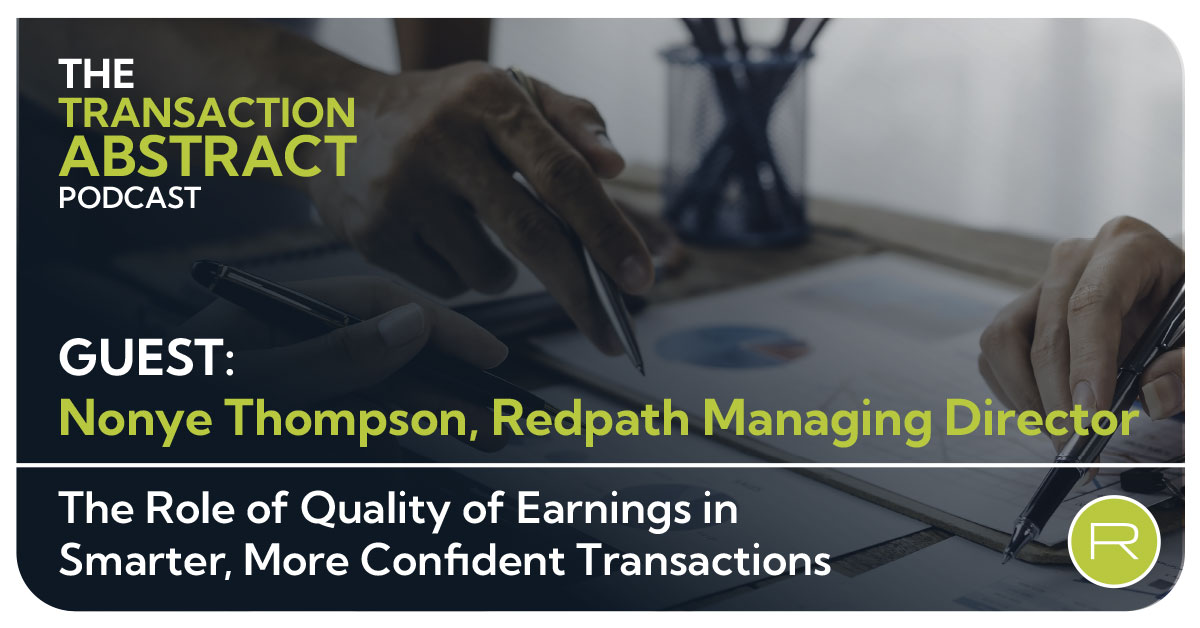The Role of Quality of Earnings in Smarter, More Confident Transactions
In this episode of The Transaction Abstract Podcast, Joe Hellman sits down with Nonye Thompson, Managing Director in Redpath’s Transaction Advisory...
4 min read
 Redpath and Company
:
Aug 5, 2021
Redpath and Company
:
Aug 5, 2021
![Why a One-Size-Fits-All Approach to Business Valuations May Mean Money Left on the Table [PODCAST]](https://www.redpathcpas.com/hubfs/business%20valuation%20types.png)
Businesses have valuations done for a variety of reasons ranging from gift and estate tax planning, to annual ESOP (employee stock ownership plan) valuations, to selling a company outright, and everywhere in-between. But a business valuation done for one purpose does not necessarily translate to another use, and using a non-sale-specific valuation for a buy or sell transaction could mean you are leaving significant money on the table.
On today’s episode of The Transaction Abstract, we sit down with Mathew Marcussen, Vice President at BMO Capital Markets, to discuss business valuation — from when to use different types of valuations and their impacts, to maximizing net proceeds and the nuances behind valuing pre-profit businesses.
Listen to this conversation on The Transaction Abstract, a podcast from Redpath:
Marcussen has been in the financial services industry for nearly a decade. He started his career concentrating on valuations and enhancing returns for ESOPs and privately-owned businesses. Today, he helps private family-owned business owners sell their businesses within the middle-market M&A group at BMO Harris.
There are many ways to place a value on a business, and buyers and sellers use different methods for different reasons.
The Asset Approach uses adjusted net assets where the book value of the company is converted to fair market value. This can be good for companies that have a lot of expensive physical assets, especially if those assets drive earnings. It can be adjusted for things like brand recognition or the reputation of the company.
Income-based valuations like Discounted Cash Flow (DCF) or Capitalization of Earnings look at the historical and projected revenue of the company and adjust it based on the risk of the investment. These methods require solid short- and long-term cash flow projections and are company-specific. A multiple of the valuation is then used to set the market value.
Financial buyers like private equity firms may use a Leveraged Buyout Methodology to determine the value of a company. In this method, the debt that the buyer incurs to purchase the company becomes a factor in the rate of return that the buyer sees in the purchase. The company’s assets and revenue are used to help pay the debt, and the money is reinvested in the company to accelerate profits before the financial buyer exits the company at some point in the future.
Comparable Companies or Comparable Sales are regularly used to determine the value of a company. This method requires researching into the public records of comparable companies or comparable sales to determine a fair market value for the company.
Comparable Companies is frequently used to report the value of an ESOP. “It's performed in a vacuum,” says Marcussen. “I would call it academic in nature as opposed to actually engaging an M&A advisor and reaching out to buyers and seeing what they would actually pay for the business.”
We generally see two types of buyers: strategic and financial. A strategic buyer usually realizes synergies with the purchase, and has a deep understanding of the business or industry from the onset. They may be willing to pay a premium to expand the company into a strategically important market or business area where they have identified an opportunity.
Financial buyers, such as private equity firms or investment groups, are interested in the financial return that can be achieved from the purchase. These types of buyers usually supply investment capital to help a business grow over a set term, most often five to seven years.
When marketing a business on behalf of an owner, you are often trying to find out who will pay the most for that business. “In the context of running an actual sell-side, [...] you get indications of interest in and you could have a scenario whereby the lowest indication of interest is half of what the highest indication of interest is,” explains Marcussen. “It's all based on the subjectivity of the buyer and how attractive the asset you are marketing is to that buyer.”
This is where a non-specific valuation can really hurt you. If you have had a valuation done for one purpose, such as an estate plan, and you receive an unsolicited offer for more than that value - you may think the offer is a good deal. But in reality, with the competitive tension of a full process, you could realize a much larger return on your life’s work. Marcussen explains, “it's all subject to negotiation, in real hand-to-hand combat when you're marketing a business for real to a group of buyers, as opposed to employing theory in a fair market valuation.”
The amount of cash (or capital) currently available around the world has a significant impact on valuations. Financial buyers are sitting on a lot of so-called “dry powder” while they look for ways to maximize cash-on-cash returns for investors. Additionally, the widespread availability of historically low debt financing contributes to driving up valuation multiples in the current market.
Along with cheap debt financing, or low-interest rates, trying to close by the year-end is also driving the urgency around valuations. “Everyone's trying to get things done before any potential change in taxes,” says Joe Hellman, Transaction Advisory Services lead at Redpath and Company.
“It's more about deal timing than anything,” Marcussen explains. “You want to maximize net proceeds if you're a seller, and what that could mean from an enterprise value perspective is material. The hurdle you have to get over today with lower tax rates is much lower than the hurdle you'll have to get over if tax rates increase. I think it's a determination that's being made by the sellers on whether or not to keep their business or, to take advantage of the current tax regime.”
Some businesses looking to sell may have a solid proof of concept, great technology, or other redeeming factors that represent value, but they may be in the red or have not yet turned a profit. These are more difficult to value. “Buyers or investors begin to place more emphasis on non-financial metrics,” Marcussen explains. “And those could be how advanced the concept or business plan is, the stage of tech development, number of users anticipated growth or, you know, number of PhDs on the platform. It can vary widely and it just depends on the company.” For these businesses, he advises asking the following:
“It's a little bit different than looking at a traditional middle-market business that has profitability that's already free cash flowing. You just have to tilt that lens a little bit and look at things a little bit differently.”
“Valuations are at all-time highs, driven by capital available to be deployed, given by investors' desires for returns, and driven by the cheap debt financing available in the market today,” says Marcussen when asked about his predictions for the future. But he says there is potential for them to go higher or lower — a testament to the ever-changing market.
He advises, “For all the business owners out there: don’t assume a valuation you’ve received for one objective translates to another, it’s always good to just get a second opinion.” For business owners looking to sell, you must remember that the value of your business is what a buyer is willing to pay you today.

In this episode of The Transaction Abstract Podcast, Joe Hellman sits down with Nonye Thompson, Managing Director in Redpath’s Transaction Advisory...

In this episode of The Transaction Abstract Podcast, Joe Hellman sits down with Dan Hennessey, the newly appointed CEO of Sam Schwartz Pedestrian...
![Common Legal Pitfalls in M&A Transactions with Kim Lowe [PODCAST]](https://www.redpathcpas.com/hubfs/Podcast-Legal-Pitfalls-Kim-Lowe.jpg)
In this episode of The Transaction Abstract Podcast, Joe Hellman sits down with Kim Lowe, Partner at Avisen Legal, to discuss the most common legal...